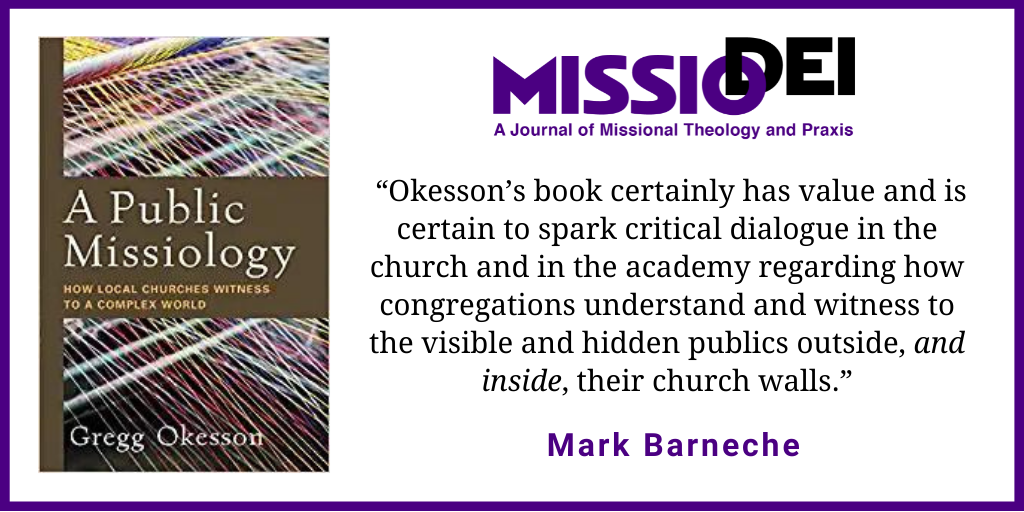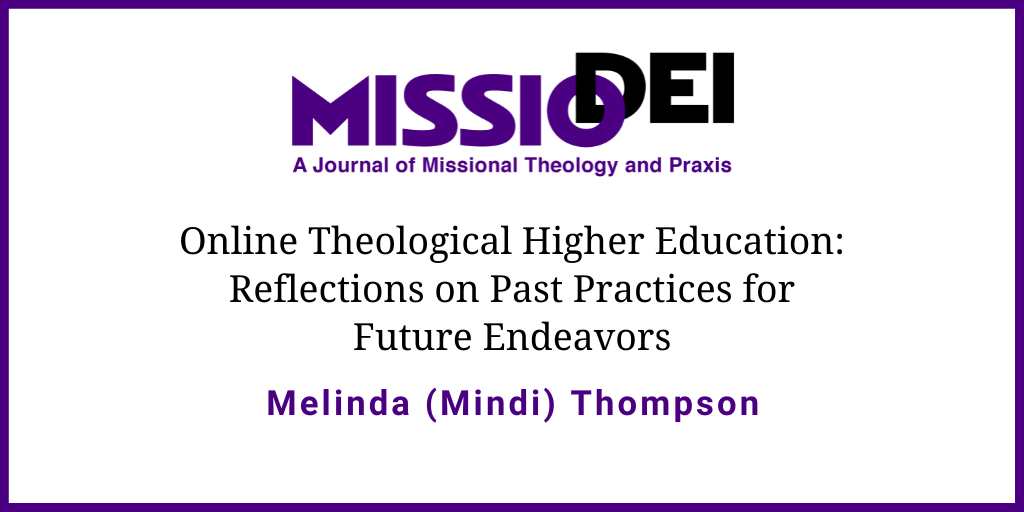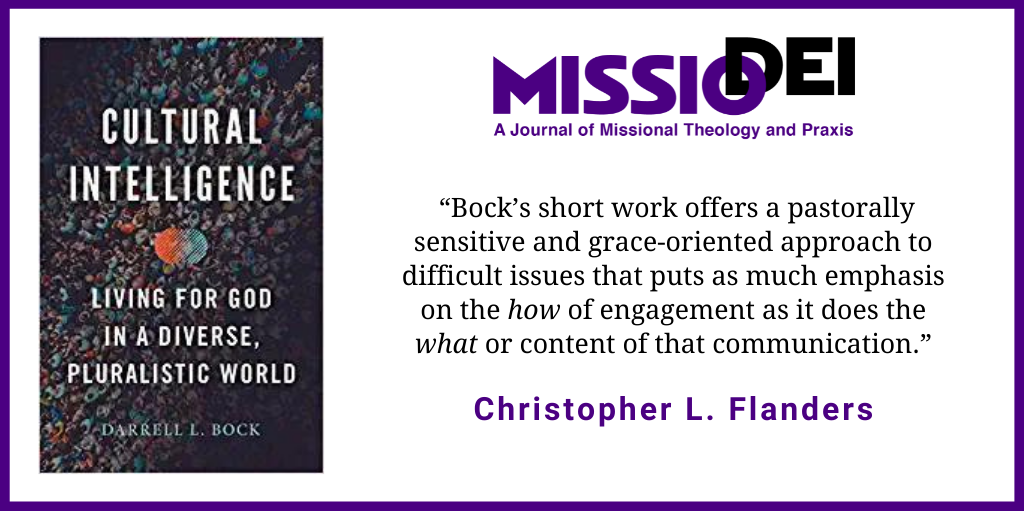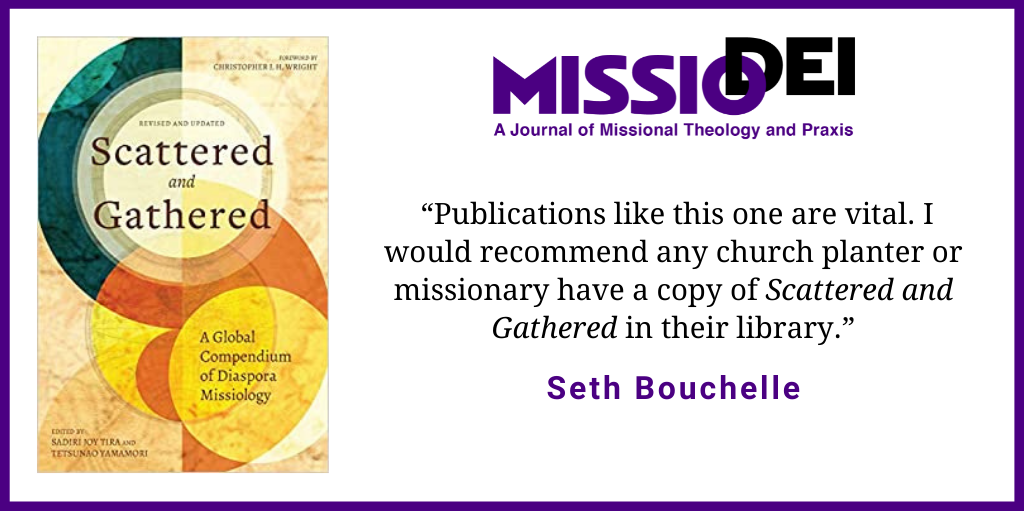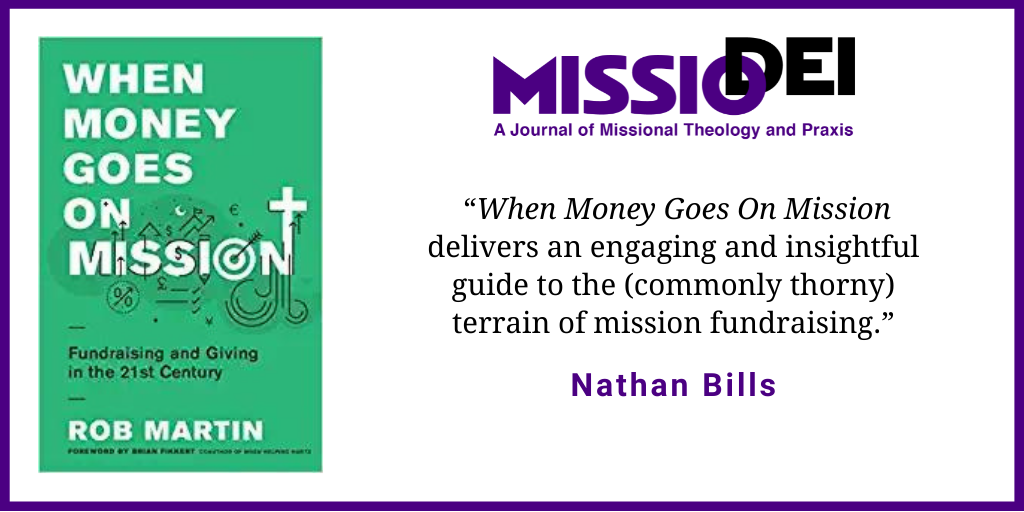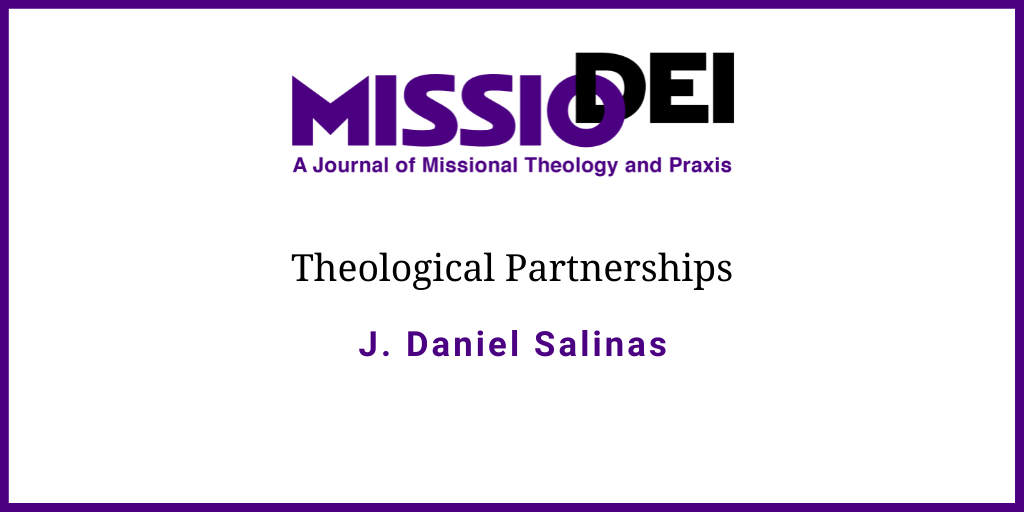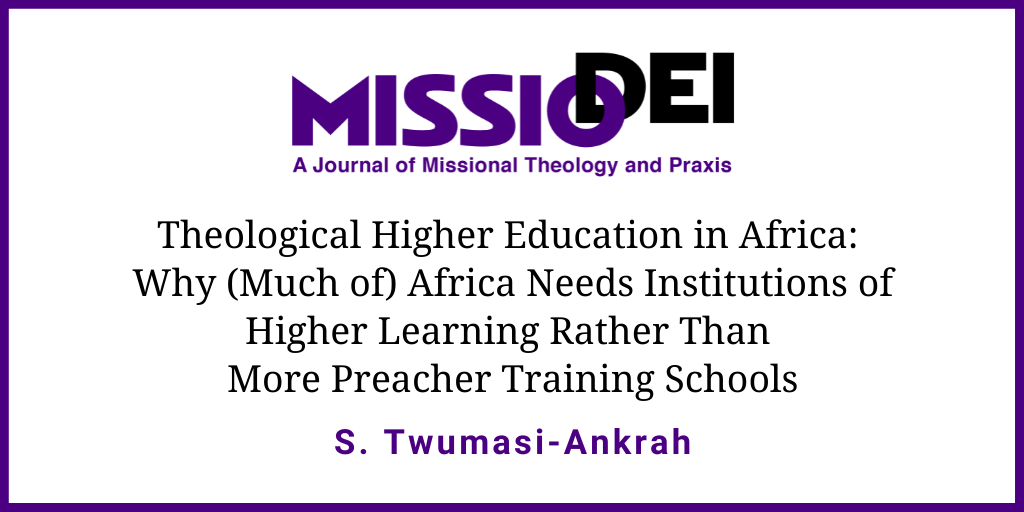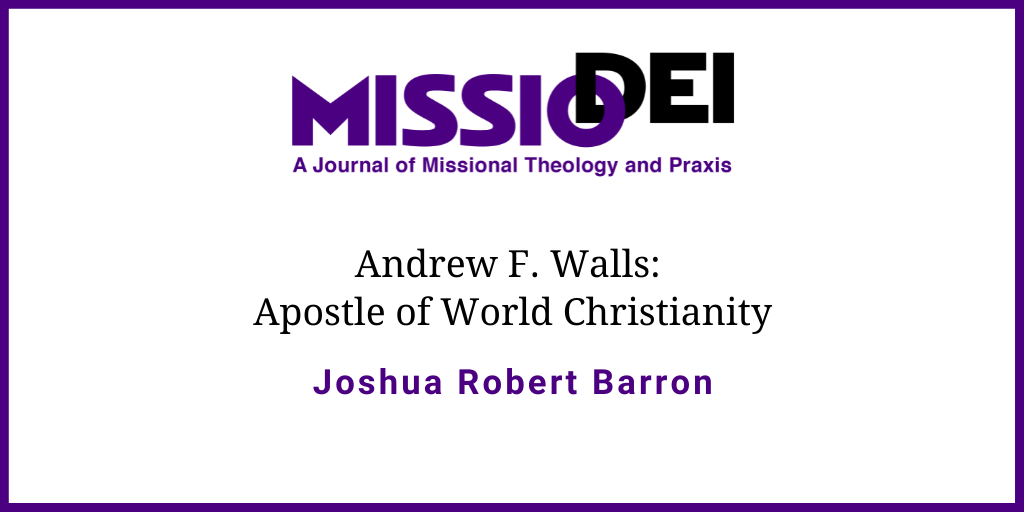
Andrew Walls (1928–2021) “may be the most important person you don’t know.” During his life, he was broadly recognized as the doyen of the study of world Christianity—that is, the study of world Christianity as a single, though multidisciplinary, field incorporating church history, missions history, missiological theory, and missional praxis. Through his tireless work with the Centre for the Study of Non-Western Christianity (which he founded at Aberdeen, then moved to Edinburgh, later renamed as the Centre for the Study of World Christianity) and with the Yale-Edinburgh Group on World Christianity and the History of Mission (which he co-founded with Lamin Sanneh of The Gambia, then a professor at Yale), and through his mentoring of so many leading scholars who take the approach of world Christianity rather than a traditional Western approach, Andrew Walls is rightly recognized as a principle founder of the study of world Christianity. This essay reviews the impact of his life and scholarship on the fields of world Christianity and missions studies and aims to introduce him to Missio Dei readers who may not be familiar with his work.
Introduction
The world of missiologists, historians of African Christianity, African theologians, and scholars of world Christianity was recently saddened to learn of the death of Professor Andrew F. Walls on August 12, 2021. Walls has rightly been celebrated not only as a preeminent historian of Christian missions and missiologist and as a strong advocate for African Christianity but also as the leading founder of the study of world Christianity. So it is an appropriate time to introduce his life and work, which have had a tremendous impact on the missional theology and praxis of so many of us, to those who are not familiar with him.
Andrew Walls’s original plan for his life was to serve as a missionary in China, like Hudson Taylor. The communist revolution and consequent expulsion of missionaries put an end to that plan. Instead, he spent a term as a missionary teacher in Sierra Leone followed by a term in Nigeria (the civil war there, 1967–1970, prevented his return for a second term). These vicissitudes of history ultimately led to his founding of the Centre for the Study of Christianity in the Non-Western World at Aberdeen, which later moved to Edinburgh and was eventually renamed the Centre for the Study of World Christianity—key events in the development of the study of world Christianity as a multidisciplinary academic field, which examines local expressions of Christianity across time and geography on their own terms. It no longer privileges Mediterranean and European traditions, which typically have separated the history of Christianity outside of Euro-American Christendom from “church history” proper, ascribing to non-Western Christianity the (assumed lower) status of either “missions history” or, as I have frequently heard it, “the history of those heretical Nestorians and Monophysites.” Consequently, the study of world Christianity operates from a perspective of academic and epistemic humility, much as Andrew F. Walls himself was accustomed to do.
I first came under Walls’s influence through his writings as a graduate student. As his books became available—The Missionary Movement in Christian History: Studies in the Transmission of Faith (1996), The Cross-Cultural Process in Christian History: Studies in the Transmission and Appropriation of Faith (2002), and the volume he edited with Cathy Ross, Mission in the 21st Century: Exploring the Five Marks of Global Mission (2008)—I have become one of many whom he has “caught on fire.” More recently, as a PhD student I became one of his many mentees. His thought—through his writings, lectures, and especially a seminar course I took from him—has been equally challenging and transformative for me. I learned from him that “theology is always a hazardous business” and that “the past cannot be suppressed, nor can it be left untouched by Christ. The past, with its identity-shaping cultural traditions, has to be converted, turned toward Christ.” Those insights have shaped and directed my own approaches to ministry as a career missionary.
In this essay introducing the person and impact of Andrew Walls, I start by offering a short biography. As he began his life as a missional scholar of Christian history, it is fitting that I then move to examine the “then and now” of scholarship arising from Christian mission, as seen through Walls’s eyes. I then examine five key elements of his scholarship: recognition and exploration of the place of Africa in Christian history, the “indigenizing” and “pilgrim principles,” the nature of Christian conversion, the possibility for contemporary “Ephesian moments,” and the serial nature of Christian expansion. Along the way I touch on Walls’s understanding of the translatability of both Scripture and of the Christian faith itself, with the concomitant importance of vernacular theologizing. While I try to refrain from writing a hagiographic panegyric, I close with a brief tribute to articulate my grief at the death of a man who was a dear mentor to me.
Biography: The Origen of the Twentieth and Twenty-First Centuries?
From Scotland to Africa to Scotland to the World
Walls once went “in Quest of the Father of Mission Studies.” He determined that this was the second- and third-century Christian theologian, scholar, and pastor Origen of Alexandria. Origen provided a new theological synthesis between Hellenistic culture and learning and the Christian faith in a fashion that enabled Greek learning to lead people to God in Christ. He did this through immense scholarly achievements and either invented or enlivened “new areas of scholarship” while acting as an effective mentor with pastoral sensitivity. In many ways, Walls is the Origen of his generation. He is a pioneer—and many say the father—of the study of world Christianity as an academic discipline. His emphasis on the place of Africa within Christianity and the polycentric nature of Christianity, his re-discovery of the serial nature of Christian expansion, his development of the “indigenizing” and “pilgrim principles,” and his contribution to a proper understanding of what Christian conversion is (and is not), have all played an important role in this shift. Within the English-speaking world, he may have been the foremost missiologist and historian of Christian mission within his lifetime. His influence has been immeasurable. His roles in the founding of three academic journals; his founding of the Centre for the Study of World Christianity, sparking a proliferation of other such institutions; and his co-founding (with Lamin Sanneh) of the Yale-Edinburgh Group on World Christianity and the History of Mission indicate the breadth of his influence. Missiologists as diverse as Lamin Sanneh, Peter C. Phan, David Bosch, Wilbert Shenk, and Brian Stanley all have spoken highly of him with gratitude for his impact on their own work.
While the lists of Andrew Walls’s published articles and chapters make a long bibliography (the list I maintain fills 36 pages), he was not a prolific author of monographs. This is because—consistent with emphases in his teaching—he was not particularly interested in scholarly prestige and advancement. He was rather interested in the advancement of God’s kingdom. His own contribution to that advancement is perhaps best seen not in his own preaching on the Methodist circuit in Scotland or through his tremendous academic output but rather through the many people whom he has mentored. One of his most famous mentees was Kwame Bediako, the author of Theology and Identity: The Impact of Culture upon Christian Thought in the Second Century and Modern Africa and the co-founder, with Professor Gillian Mary Bediako, of the Akrofi-Christaller Institute of Theology, Mission and Culture (ACI) in Akropong, Ghana. Bediako notes that Walls has authored “many more books that can’t be listed on paper; I am one of those books.” Andrew Walls was interested in making disciple-making disciples for whom scholarship arises from Christian mission and serves to continue the mission.
Background: Oxford Scholar and Methodist Preacher
Educated at Oxford University (BTh with honors [1948], MA [1952], BLit [1954]), Walls studied patristics under F. L. Cross. At around the age of 25 (in 1953), he became a lay Methodist preacher in the Aberdeen area. I. Howard Marshall observes that in his preaching on the Methodist circuit in the Aberdeen area as a young man, ministering to ordinary folk well outside of the academy, “there is never any attempt to lecture the congregation or give a display of scholarship. There is, needless to say, a depth of understanding in [his sermons] that equally appeals to the more educated and theologically literate members of the congregations.” He was well-known locally for his hymnody, composing enough hymns to fill a small hymnal for use in the local Methodist congregations.
Missionary Beginnings: Sierra Leone and Nigeria
In his thirtieth year (1957), he moved with his wife Doreen to Sierra Leone to serve as a lecturer in church history at Fourah Bay College (later the Fourah Bay University College Theology Department). Classically trained, his vision of church history followed the Western bias of moving from Jerusalem to Antioch to Rome to the Protestant Reformation to the Reformation in the British Isles, with everything to the South and East being largely forgotten with each historical progression. He was fully prepared, as was customary, to impart the lessons of church history “to the ‘younger churches’ from the accumulated wisdom of the older ones.” It was while in Sierra Leone that a seismic shift in his thinking took place. While teaching African students the history of Christianity in the second century, he realized that he was surrounded by an analogous moment in Christian history. This led to new paradigmatic approaches in his teaching and to an awareness of the importance of the interaction of Christian faith with cultures and of the importance to study non-Western Christianity as Christianity on its own terms. While he was certainly already a competent lecturer and scholar, he later took a rather dim view of his approach to scholarship and teaching prior to his shift in vision: “I still remember the force with which one day the realization struck me that I, while happily pontificating on that patchwork quilt of diverse fragments that constitutes second-century Christian literature, was actually living in a second-century church. The life, worship, and understanding of a community in its second century of Christian allegiance was going on all around me. Why did I not stop pontificating and observe what was going on?” This marked the beginning of his journey as a student and scholar of world Christianity. Before his time in Africa, he had made the effort “to learn Old Norse in order to study the pre-Christian primal religions in Europe,” adding that to the Greek, Latin, and Syriac which he had learned to study Christian origins and to his working knowledge of French. He now recognized the importance both of African languages and traditional religions within their cultures. While teaching at Fourah Bay College, in 1959 he became the founding editor of The Sierra Leone Bulletin of Religion, published by the school’s Faculty of Theology to address the very concerns and contextual realities to which Walls had recently awakened.
In 1962 Andrew Walls was invited to establish the Department of Religious Studies at the new University at Nsukka in Nigeria. It was during his tenure there that he realized that, compared to what we know about pre-Nicene Christianity within the Roman and Persian Empires, there are abundant resources to study the contemporary African Church. He began to study African Christianity in earnest, not just as a local missionary expression of the Western Church.
Aberdeen, Edinburgh, and the Study of Christianity in the Non-Western World
At the age of 38, in 1966 he answered a call to become a lecturer in church history at the School of Divinity of the University of Aberdeen, where he taught from 1966 to 1985. In 1967, he became the founding editor of the Journal of Religion in Africa (published by Brill). In 1970, Walls was appointed as the founding head of the newly established Department of Religious Studies at Aberdeen. Eventually, in 1982, Walls founded the Centre for the Study of Christianity in the Non-Western World (CSCNWW) at Aberdeen. After his time in West Africa (in Sierra Leone and Nigeria), and having observed the ongoing demographic shift in world Christianity from the West to the Global South, he had “no doubt that the immediate future of Christianity lay in the southern hemisphere. But he had also become increasingly aware that this new and exciting chapter in Christian history could not be adequately written in the years to come unless some serious and urgent initiatives were taken to document and interpret the rapid growth and rich diversification of southern Christianity. The Centre for the Study of Christianity in the Non-Western World developed from Andrew’s awareness of this compelling need.” Walls’s work with CSCNWW led directly to his insights on the place of Africa in Christian history, the global nature of World Christianity, and the serial nature of Christian expansion throughout history; these developments will be discussed below.
In 1986, Walls was persuaded by James P. Mackey, then Dean of the Faculty of Divinity at New College, University of Edinburgh, to move from Aberdeen to Edinburgh, talking CSCNWW with him; the Centre was renamed “Centre for the Study of World Christianity” (CSWC) in 2009. In 1987, he was appointed to the additional position of Professor of Theology, Mission, and Culture at the newly founded Akrofi-Christaller Institute (ACI) in Ghana; he remained intimately connected with ACI for the rest of his life, taking the time to become conversant in the Twi language. In 1992, he co-founded the Yale-Edinburgh Group, which has proven an immense benefit to scholars of Christian mission and of world Christianity around the world. Upon retirement in 1995, Walls established the journal Studies in World Christianity, with Mackey serving as the founding editor. His role in establishing this journal, as the establishment of the two aforementioned journals, was motivated in part by his personal emphasis on encouraging the scholarship of others. In the first article of the first issue of Studies in World Christianity, Walls defines what we now call the study of world Christianity as “the interdisciplinary study of the Christian faith in its worldwide manifestations and in its relations to other faiths and cultures.”
Post-“Retirement”: Doyen of World Christianity
Professor Walls has retired and come out of retirement more than once, and he continued his faithful ministry until his recent death at the age of 93. From 1997 to 2001 he served as Guest Professor of Ecumenics and Mission Research at Princeton Theological Seminary and Visiting Professor of World Christianity at both Yale University and Harvard University. In 2008, Liverpool Hope University founded the Andrew F. Walls Centre for the Study of African and Asian Christianity, hiring Walls out of retirement again. At the time of his death, he held two academic posts in the UK (Professor of the History of Mission at Liverpool Hope University and Honorary Professor at the University of Edinburgh) and two in Africa (Professor Emeritus at the Akrofi-Christaller Institute of Theology, Mission and Culture in Akropong, Ghana and Research Professor at the Centre for World Christianity at Africa International University in Nairobi, Kenya).
Within the context of Walls’s African experience, he has brought to light—in both the ancient and contemporary church—the multicentricity, non-Westernness (including the recent Southward demographic shift of Christianity), and dynamism (especially as related to translation and culture issues) of the global church. In his teaching methodology, Walls “believes that students should learn to enter the minds of those who belong to the periods they study. Accordingly, most of his quotations are taken directly from the persons under study—the primary sources—and not from others’ comments about them or references to the period. Since he considers primary sources the vital indicators of mission activity, he would rather cite documents from the specific periods.” To honor both his memory and his method, in the following sections I will use more and longer quotations from Prof Andrew’s work than is customary.
Scholarship Arising from Mission: Then
The crossing of cultural and linguistic boundaries by Christian mission demands theologizing. Noting that “a lively concern for Christian living and Christian witness has repeatedly called scholarly activity into existence,” Walls has often discussed this process in the early church, pointing out that such concern is a need for scholarship whenever the gospel crosses a cultural frontier. The first cultural frontier which the gospel encountered was “that between Israel and the Hellenistic world. The business of constructing a Hellenistic Christian lifestyle, a Greek way of being Christian, was intellectually demanding. In particular once the word about Jesus Christ was translated into Greek, and entered into a Greek thought-world without the built-in controls natural to Greek-speaking Jews, all sorts of new questions (for instance, about the proper way to express the relationship between the divine savior and the one God), were raised that were not likely to be aired when all the believers in Jesus were Jews.” This is evident in the writings of the New Testament, which were written in Greek to churches composed of Christians of both Jewish and Hellenistic backgrounds. It is only to be expected that “as the Christian mission to the Greek world expanded, Christian theology expanded too.” All languages have both strengths and limitations. Christians who think in Hebrew or Aramaic or even in Greek within the context of traditional first-century Jewish worldviews were able to make a certain set of discoveries about the Christ, whom Simon Peter identified as the (Jewish) Messiah and the Son of the living God (Matt 16:15). But when Christians thinking and speaking in Greek from within “Greek indigenous categories” of thought and worldview expressed their deepest convictions about Christ within indigenous forms of communication, rhetoric, and debate, they were able to make new discoveries about Christ. Theology is always contingent upon language and culture. This can be a strength or a weakness. The role of Christian scholarship is to separate the wheat of “genuine discoveries” from the chaff of “false trails.” Walls explains this process through the examples of Paul, Justin Martyr (c. 100–c. 165), and Origen (c. 184–c. 253).
As Christianity crossed the cultural frontiers from Messianic Judaism into Hellenistic thought, new theological issues were opened which “could only be pursued in the Greek language, using Greek categories of thought such as ousia and hypostasis and Greek methods of debate, the intellectual materials to hand.” This new theologizing took place when Christians asked “Greek questions in the Greek language, questions that were neither raised nor settled by using Hebrew categories such as messiah.” The Jerusalem Council discerned that conversion rather than proselytization was the way forward, thereby setting aside circumcision and strict Torah-observance. As a result Christians were “forced . . . to make choices” as “a new Christian lifestyle had to be devised under the guidance of the Holy Spirit now poured out on Gentiles: a Hellenistic way of following Jesus and a converted pattern of Hellenistic social and family life.” New converts were tasked with modeling “converted Hellenistic social life as the old believers modeled converted Judaism. . . . The new Christians were not proselytes, following the converted cultural pattern of earlier believers; they were converts, needing, under the guidance of the Holy Spirit, to turn the ways of their own societies toward Christ. Conversion is less about content than about direction. It is about turning toward Christ what is already there.” How is this to be done? In studying the earliest days of the church, scholar Eckhard Schnabel observes that “the question is not whether Christians should adopt or reject the behavioral patterns of non-Christian society—that question is posed by outsiders. As insiders, Christians ask which values and behaviors of society they must reject because they have become different people through new birth, and which values and behaviors they can retain because they do not adversely affect life with God, and which values and behaviors they can and should transform so that they reflect the values of God’s new creation more authentically.” It was in this context that Justin Martyr wrestled with “the relationship to his own culture of the gospel.” Whereas Western scholarship focuses on Justin’s doctrine of the Logos in terms of the history of the developments of the doctrines of christology and Trinity, “it is hardly accidental that it is a modern African theologian, the late Kwame Bediako . . . [who] argues that second-century Greek theologians and mid-twentieth-century African theologians had exactly parallel concerns.”
After Justin Martyr, Irenaeus (c. 130–c. 202), and Origen, the next important development in Christian theology and praxis was the rise of the monastic movement. This movement had its beginnings in Egypt and Syria in an attempt to wrestle with the twin indigenizing and pilgrim principles discussed below and resulted in both mission and scholarship. Walls notes that Antony, the founder of Egyptian monasticism, “cannot be understood apart from his African Christian view of a power-packed spiritual universe where Christ’s victory must be displayed.” Walls notes that with many similarities to the story of African Christianity during the past century, “the first stream of African Christian witness” as represented in the martyrs of Scilli met the principalities and powers in the structures of society and paid with their blood. The second stream, represented in Antony, met them as spiritual forces deep in the constitution of the universe. They realized that those forces were impregnable to easygoing discipleship. Only when disciples took up the cross in order to be indeed Christ’s disciples were they broken.”
Scholarship Arising from Mission: Now
Andrew Walls observes, “each time the gospel crosses a cultural frontier, new issues will arise, first of the ‘What should I do?’ and then of the ‘How should I think?’ category, many never faced by Christians before. Each time the gospel crosses a cultural frontier, a fresh set of intellectual materials is available for the task.” Thus “subsequent crosscultural movements of the Christian faith open the way to theological discovery by raising questions in other languages that have no answer in the terms of another culture.” The modern “missionary movement, out of its essential concern to communicate the gospel, was forced”—repeatedly—“into innovative scholarship.” Walls notes that “cross-cultural diffusion (which is the life-blood of historic Christianity) has to go beyond language, the outer skin of culture, into the processes of thinking and choosing, and all the networks of relationship that lie beneath language, turning them all towards Christ.” This “deep translation,” which takes place over several generations because those cultural processes themselves took generations to develop, is “the appropriation of the Christian gospel” within a given culture “down to the very roots of identity.” Indeed, the “Christian faith must go on being translated, must continuously enter into vernacular culture and interact with it, or it withers and fades.” Walls observes that this long act of translation “helps not only to communicate the gospel, but to enlarge and enrich the church’s understanding of it. Such deep translation needs the sustained exercise of corporate examination (individual insights, however brilliant, are inadequate), and steady discrimination. Deep translation is necessary to deep mission. So periods of active mission need to be periods of active scholarship. The converse is also true; when the sense of mission is dulled or diverted, the death knell sounds for Christian scholarship.” Because “authentic theological scholarship must arise out of Christian mission” it must arise “from the principal theatres of mission. Theology is about making Christian decisions in critical situations, and it is in the southern continents that those decisions will be most pressing, and the key theological developments are accordingly to be looked for.” We will now turn our focus toward one of those southern continents.
1. The Place of Africa in Christian History
Walls discussed at length the essential non-Westernness of Christianity. Western Christendom, or Christianity as territorially expressed in Europe, was long assumed by its members to be Christianity. But Christianity as a specifically Western faith was a historical anomaly that has now retreated. This does not mean that Western forms of Christianity are not or cannot be authentically Christian. Rather, it means that it is no longer possible to assume that Western forms of Christianity are representative of world Christianity as a whole. Though Walls was among the first to notice this, historians of Christianity and other observers have increasingly recognized that there has been a major shift in the center of gravity of the Christian world from the West (specifically Western Europe and North America) to the Global South. Already,
more than half of the world’s Christians live in Africa, Asia, Latin America, or the Pacific, and . . . the proportion doing so grows annually. This means that we have to regard African Christianity as potentially the representative Christianity of the twenty-first century. The representative Christianity of the second and third and fourth centuries was shaped by events and processes at work in the Mediterranean world. In later times it was events and processes among the barbarian peoples of northern and western Europe, or in Russia, or modern western Europe, or the North Atlantic world that produced the representative Christianity of those times. The Christianity typical of the twenty-first century will be shaped by the events and processes that take place in the southern continents, and above all by those that take place in Africa.
Within Christendom, it was once reasonable (though myopic and ill-informed even then) to equate European culture with Christianity, but that is no longer the case. Today “Christianity has become so much a part of the fabric of sub-Saharan African life that scholars in a wide variety of disciplines who want to undertake serious study of Africa need to know something about Christianity.” Walls hastens to add that “anyone who wishes to undertake serious study of Christianity these days needs to know something about Africa. It follows that the student of Christian history not only must know something about Africa but also must consider the part that Africa plays in the total story of the faith.”
Walls seems to savor that “a special place for Africa in the history of redemption is hinted at in the New Testament itself.” In Luke’s second volume, The Acts of the Apostles, his primary purpose is to show (some of) the story of how the Christian faith traveled westward from Jerusalem to Rome. The first chapters recount “the development of the Jerusalem church and the life of the Jewish Christians who had recognised in Jesus the Messiah of Israel. Later chapters “show the birth of Hellenistic Christianity at Antioch and the westward progress of the message about Jesus across Asia Minor over southeastern Europe to Rome.” Sandwiched between these two narratives is the episode about Phillip and the Ethiopian Eunuch, an official of the kingdom of Meroë in the Sudan (ancient Nubia). Walls ponders why the Lucan narrative, which joins “Stephen with Saul and the church of Antioch,” is broken to record this short episode. We don’t learn what happens after this African government official returns home, and the pericope ends abruptly. But Luke emphasizes
the providential nature of the meeting; it is no chance encounter. The whole way the story is framed is a reminder that Africa, the lands beyond the Nile, will have a Christian history too—one that is not yet charted, and one that is distinct from the story of Asia and Europe, which is the concern of the Acts of the Apostles. It is distinct, but not entirely separate; the Ethiopian is, after all, an international traveller who knows the highways of the Greco-Roman world. In the Acts story, he comes as a pilgrim, and returns as a Christian. Perhaps it is not too fanciful to take a hint that he, or his spiritual descendants, may one day travel those highways again as the representatives and bearers of the Christian gospel.
Many assume that “the early history of Christianity in Africa has nothing to do with the contemporary Christianity of Ghana and Sierra Leone and Nigeria” and “that Christianity is essentially an import from the West.” Walls highlights three factors which refute such assumptions:
- “the unbroken historical continuity of the churches of Egypt and Ethiopia of today and the ancient world;”
- “the degree of commonalty between northern and sub-Saharan Africa. . . . No purely geographical factor finally divides Mediterranean Africa from tropical Africa;”
- “the wider use of the name Ethiopia” in which “Ethiopia stands for Africa indigenously Christian, Africa primordially Christian; for a Christianity that was established in Africa not only before the white people came, but before Islam came; for a Christianity that has been continuously in Arica for far longer than it has in Scotland, and infinitely longer than it has in the United States. . . . African Christians today can assert their right to the whole history of Christianity in Africa, stretching back almost to the apostolic age.”
An African Christian theologian, Athanasius of Alexandria (c. 296–373), could well be called the father of Orthodox Christian Theology in view of his successful defense of Nicene doctrine against Arianism. It was African Christian theologians—Origen and Athanasius in the Greek east together with Tertullian (c. 155–c. 220) and Cyprian of Carthage (c. 210–285) and Augustine of Hippo (354–430)—who were responsible for laying the foundations of Western Christianity. More than this, “one might say that the vernacular principle in Christianity was earliest exemplified in Africa; among the earliest known translations of the New Testament are the Sahidic of Lower Egypt and the Latin of Roman Africa.” Indeed, because “the principal early Christian interaction with Latin language and culture took place in Roman Africa” we should note that in point of fact, “Western theology is an African artifact.” Today Christianity is as African as it has ever been. One evidence of this is that “in most parts of Africa . . . the Christian God has a vernacular name—a name in common speech, to indicate the God of Israel and of the Scriptures” and thus we can see that “it is Christianity, not Islam, that has struck its roots into the vernacular past” of Africa.
As I share Walls’s heart for the African Church, it is fitting that I conclude this section with the concerns of a Wallsian missiological focus, looking forward toward future tasks of Christian theology in Africa. Walls has noted that African Christian theology requires an African theological education that is not dominated by a particular chapter of church history during which the West was dominant. I once heard him remark that the majority of Christians had “no experience with the 16th century,” observing that while the Reformation and Counter Reformation were and are important, they are not the whole of the Christian story and should not form the template that the Western church forces the rest of the church within world Christianity to follow. Thus in African theological scholarship, Africa’s past cannot be suppressed but must be both remembered and incorporated. In this task, Africa has the benefit of not being mired in the categories of Enlightenment thought. African theological activity must arise out of ongoing “Christian mission and Christian living, from the need for Christians to make Christian choices and to think in a Christian way” in African contexts.
2. The Indigenizing and Pilgrim Principles
According to Walls, two forces arise from the gospel’s interaction with a culture: the indigenizing principle and the pilgrim principle. The indigenizing principle can be expressed as the attempt “to live as a Christian and yet as a member of one’s own society.” The pilgrim principle reminds the believer “that he has no abiding city and warns him that to be faithful to Christ will put him out of step with his society.” In Christ, God does indeed “take people as they are”—this is the indigenizing principle at work, which enables our faith to be made “a place to feel at home” and “associates Christians with the particulars of their culture and group.” But God “takes them in order to transform them into what He wants them to be.” The resulting displacement caused by that transformation is the pilgrim principle. The experience feels like displacement but may be better called replacement, as the Christians are newly associated “with things and people outside the culture and group” as an expression of the universalizing element of the gospel.
Walls observes that “all churches are culture churches—including our own.” Because this is the case, culture matters. While Jesus spoke in Aramaic or Greek to those in first-century Jewish and Hellenistic cultures, the Scriptures also speak to us today in our diverse cultures. The first of these principles, “the indigenizing principle ensures that each community recognizes in Scripture that God is speaking to its own situation. But it also means that we all approach Scripture wearing cultural blinders, with assumptions determined by our time and place.” Walls continues: “perhaps it is not only that different ages and nations see different things in Scripture—it is that they need to see different things.” Moreover, where the church in one culture may be hindered by a blindspot, the church in another culture will see quite clearly. Thus while there may be something to be said about autocephalous churches (i.e., a regional ecclesial body that is not subject to the authority of church leaders from a different country), isolation can severely weaken any church. To state it positively, “since none of us can read the Scriptures without cultural blinkers of some sort, the great advantage, the crowning excitement which our own era of Church history has over all others, is the possibility that we may be able to read them together. Never before has the Church looked so much like the great multitude whom no man can number out of every nation and tribe and people and tongue. Never before, therefore, has there been so much potentiality for mutual enrichment and self-criticism, as God causes yet more light and truth to break forth from his word.” This is but one way in which the African church—as well as the church in the Global South generally—can offer untold riches to world Christianity.
These two principles are always at play in Christian mission. The pilgrim principle is often felt rather keenly. Indeed, “the fundamental missionary experience is to live on terms set by others. . . . The need to speak someone else’s language, the consciousness of doing it badly or even laughably, being unsure of etiquette, constant fear of giving unintended offence, realization of the vast depth and complexity of another community’s traditions and history, and thus identity.” There can be tension between the indigenizing and pilgrim principles. In a healthy (and therefore missional) church, “perhaps the real test of theological authenticity is the capacity to incorporate the history of Israel and God’s people and to treat it as one’s own.”
3. Conversion versus Proselytization
Walls’s distinction between proselytization and conversion has been particularly helpful in my own missionary career. Many consider proselytization and conversion to be synonymous, but nothing could be further from the truth. A proselyte must effectively reject his or her home culture and replace it with someone else’s culture: “to become a proselyte involves the sacrifice of national and social affiliations. It involves a form of naturalization, incorporation into another milieu.” Thus in the NT period, a Roman or Greek or Persion could proselytize to become a Jew—adopting not only the Jewish faith in Yahweh and Jewish cultural customs, but adopting Jewish ethnicity as well, abandoning their home culture and ethnicity. But Christian conversion is “a turning to God in Christ” and the process of “taking what is already there and turning it to Christ.” This conversion “is not about substitution, the replacement of something old by something new, but about transformation, the turning of the alreading existing to new account.” Importantly, and contrary to some 19th- and 20th-century missionary practice, an ethnic African convert (that is, one who turns to Christ) does not have to adopt European or American culture in order to follow Jesus. Rather, it is precisely as an African that he or she will follow Jesus.
Readers of the Gospels will recall that Jesus, who calls us to make disciples of all nations, also had extremely harsh words for proselytizers, stating that they made their proselytes not just “sons of hell” but even more severely “sons of hell” than the proselytizers themselves (Matt 23:15). And of course the Jerusalem Council in Acts 15 definitively rejected the way of proselytization once and for all in favor of the way of conversion, deciding that “the followers of Jesus are not proselytes. They are converts.” For some, the idea of becoming a Christian means abandoning one’s own culture and becoming, essentially, a foreigner. But such a process is, by definition, proselytization. Christian conversion is not the abandonment of one’s ethnic and cultural identity, nor of one’s language. Insofar as such demands have been made by Christian missionaries, those missionaries have been proselytizing rather than making disciples. Christian conversion is the process of “taking what is already there and turning it to Christ.” This takes place holistically within the social life, family life, and intellectual life of the Christian. Just as the Hellenistic peoples of the first centuries of Christianity “could not be converted without the conversion of the whole universe of Greek thought” and the very “conversion of Hellenistic culture itself,” so Christian conversion in our own day—whether in Africa or Asia or the West—must be a robust conversion that does not abandon local cultures but transforms them through turning their “processes and priorities” to Christ.
In continuity with the path laid out by the Jerusalem Council, Pope Gregory the Great (bishop of Rome from 590 to 604) ruled against proselytization as a missionary method. But proselytization has been the practice at other times. During the Spanish Inquisition, it was not enough for Moors to stop being Muslim or for Jews to confess Christ: the Moorish Christian converts had to reject Moorish cultural and ethnic identity and Jewish converts to Christianity were required to stop being ethnically and culturally Jewish. During the Great Century of the modern missionary movement, many Christian missionaries consciously thought of Christian “conversion” in terms which unmistakably describe proselytization. In Africa during this era, new believers were all too often expected to stop being African and to become European culturally and linguistically before their conversions to Christ would be accepted by missionaries as authentic. The missionaries, in those cases, failed to see that Christian conversion takes place within the context of culture. Thus, while it is best to speak of Christianity in the singular rather than of “Christianities,” it is fitting to speak of African Christianity, European Christianity, North American Christianity, Asian Christianity, and so on. Proselytization is the mere exchange of one human culture for another. It is the absolutizing and sacralizing of one human culture at the expense of others. Christian “conversion is the turning, the re-orientation, of every aspect of humanity—culture-specific humanity—to God.” Thus, the gospel enriches all cultures, insofar as members of that culture turn to Christ. Walls wrote and spoke extensively on the nature of Christian conversion, correcting errors of past praxis and calling the missionary community to restore New Testament practice.
4. Ephesians Moments
For [Christ] himself is our peace; who has made the two one and has destroyed the barrier, the dividing wall of hostility. (Eph 2:14; NIV-1984)
Another contribution of Walls that has especially impacted my thinking comes from “The Ephesian Moment: At a Crossroads in Christian History.” In his letter to the Ephesians, Paul was addressing a church composed primarily of two different parties: Jewish converts to Christ and Hellenistic believers who had converted to Christ from one or another of the traditional Greco-Roman religions. Each group came to Christ from within their own worldview. Was it not all too easy for divisions to form along ethnic and cultural lines? This diversity was of course the natural result of the decision of the Council of Jerusalem in Acts 15, “which builds cultural diversity into the Christian church forever.” But while “the church must” necessarily “be diverse because humanity is diverse,” Paul insisted that “it must be one because Christ is one.” The “dividing wall of hostility” between different groups has been torn down. The “Ephesian moment” was the opportunity for the church to choose either division along ethnic and cultural lines or to choose unity in the midst of diversity, “the social coming together of people of two cultures to experience Christ.” When Paul was writing, neither the Hellenistic portion nor the Jewish portion of Christianity were the whole church. Rather each form of Christian faith was necessary to complete and correct the other. Today, Walls teaches, the Ephesian moment has returned, though in greater richness, as the polycentric and polycultural nature of world Christianity is increasingly clear.
5. The Serial Expansion of Christianity
Walls has also made valuable contributions to the understanding of Christian expansion throughout history by highlighting its serial nature. In its beginning, the Christian faith had a clearly defined center: Jerusalem was truly the mother church. By any historical or demographic measurement, however, it has been centuries since Jerusalem was an important Christian center, save in memory and sentiment. But even within the New Testament era, Christianity began to be polycentric. Culturally and demographically, the Christian faith was no longer centered in Jerusalem and Judah but rather in various Hellenistic urban centers in the Eastern Mediterranean such as Antioch and Alexandria. Frequently, Christian vitality at the center(s) has either become stagnant or collapsed all together while new Christian growth explodes on the margins of the Christian world, or beyond them. Christian history features both periods of recession and of advance—and “the recessions typically take place in the Christian heartlands, in the areas of greatest Christian strength and influence . . . while the advances typically take place at or beyond its periphery.” This means that the Christian faith continually and repeatedly interacts with new cultures and languages and the process of conversion yields new cultural forms of Christianity. Insofar as this pattern includes periods of recession, it expresses a vulnerability. But this vulnerability is intimately linked to the vernacular nature of the Christian faith, which is in turn a strength. Walls notes that for each historical demographic and cultural shift of Christianity’s center of gravity, “a threatened eclipse of Christianity was averted by its cross-cultural diffusion. Crossing cultural boundaries has been the life blood of historic Christianity. It is also noteworthy that most of the energy for the frontier crossing has come from the periphery, rather than from the centre.” This was true when Greek-speaking Jewish Christians shared the gospel with their Gentile neighbors in Antioch in the first century, it was true of the modern missionary movement in which parachurch missionary agencies were formed to bypass the existing ecclesial structures for the sake of the Kingdom, and it is certainly true of the recent explosion of Christian growth in Africa, the South Pacific, Latin America, and parts of Asia.
Tribute
“He taught us by example, as Origen did in his time,
that at the heart of the scholarly life there lay prayer and worship.”
— Kwame Bediako on Andrew Walls
As I am a missionary and an educator who strives to speak in local vernaculars, it is fitting that I share a few observations about Walls as a teacher. When speaking with African believers in their own languages he desired, “to connect with his interlocutor and to put the other person at ease. He is always striving for that possibility of communing in the things that make them both human.” As a result of this attitude, it was while listening to Andrew Walls speak on “Africa’s place in Christian history” that Bediako realized that “in becoming Christian, I was becoming African again.” For Andrew Walls, teaching was “not the quest for knowledge for its own sake or the desire to acquire degrees and prestige. The scholarly vocation is about knowledge that leads to faith and affects the understanding of one’s calling. . . . Because it involves discipleship, it is serious business. In short, scholarship is a matter of life and death.” He therefore notes, “Scholarship as a vocation requires passionate commitment. It is not a hobby or a job but a life-long occupation.” In all respects, Walls insists that an important objective of Christian scholarship is “to maintain a community life marked by Christian mission and service.” But as strongly as his words spoke, his own actions modeled these principles even more strongly.
In September 2020, I heard prominent Nigerian theologian Afe Adogame remark that “Andrew Walls is the ‘living ancestor’ for World Christianity.” Though he was quite aged, he had been hospitalized and recovered so many times that his death caught many of us by surprise. While we were lamenting the news a few hours after his death, my colleague Wakakuholesanga Chisola observed to me that his strength had seemed greater than the frailty of his age, but then pithily remarked that “even Baobabs fall.” Baobab trees, an iconic image of the rural African skyline, are a great African symbol of strength and life; they also serve as gathering or meeting places for many traditional societies in Africa. So allow me to conclude with a poem to honor this excellent teacher and mentor who has now joined that great cloud of witnesses.
The Baobab Falls
the Baobab is mighty
the Baobab is strong
the Baobab, well-rooted,
reaches to the sky,
giving shade and fruit and wisdom
to all us passers-by
the Baobab was mighty
the Baobab was strong
the Baobab, well-rooted,
branches far and wide,
shared his wealth of Christly wisdom
to all, yes, even I
but Baobab has fallen
and we are now bereft
our thoughts are now uprooted
Teacher, Mentor, Friend!
tears like Mosi-oa-Tunya
cry our lamentation
Prof Andrew well did teach us
of agency and hope
from Africa to Scotland
falcon-swift he flew—
tears like Mosi-oa-Tunya
flow from hearts now rended
Prof Andrew well did lead us
challenging for truth
through polycentric story
into faith’s true girth
thus from Accra to Nairobi
with academic mirth
Prof Andrew Walls has left us
and we are now bereft
yet he will rise eternal
and we can rejoice
he won his race and fought his fight
his sorrow will now end
Prof Andrew Walls has left us
strong branches wide and fair
in life he pointed upward
now he upward flies
asking who will foster forests
new Baobabs to tend?
Prof Andrew Walls was mighty
Prof Andrew Walls was strong
Prof Andrew Walls, well-rooted,
pointed past the sky
giving wealth of Christly wisdom
to all us passers-by.
A graduate of Milligan University (1995) and Emmanuel Christian Seminary (2000), Joshua has missions experience in Papua New Guinea (1993), India (1995 and 1998), South Africa (2000–2001), and Kenya, where he and his family have served since 2007. He is a PhD student at the Centre for World Christianity, Africa International University, Nairobi, Kenya. A staff member of ACTEA (Association for Christian Theological Education in Africa), he is also a PhD student at the Centre for World Christianity, Africa International University, Nairobi, Kenya.
